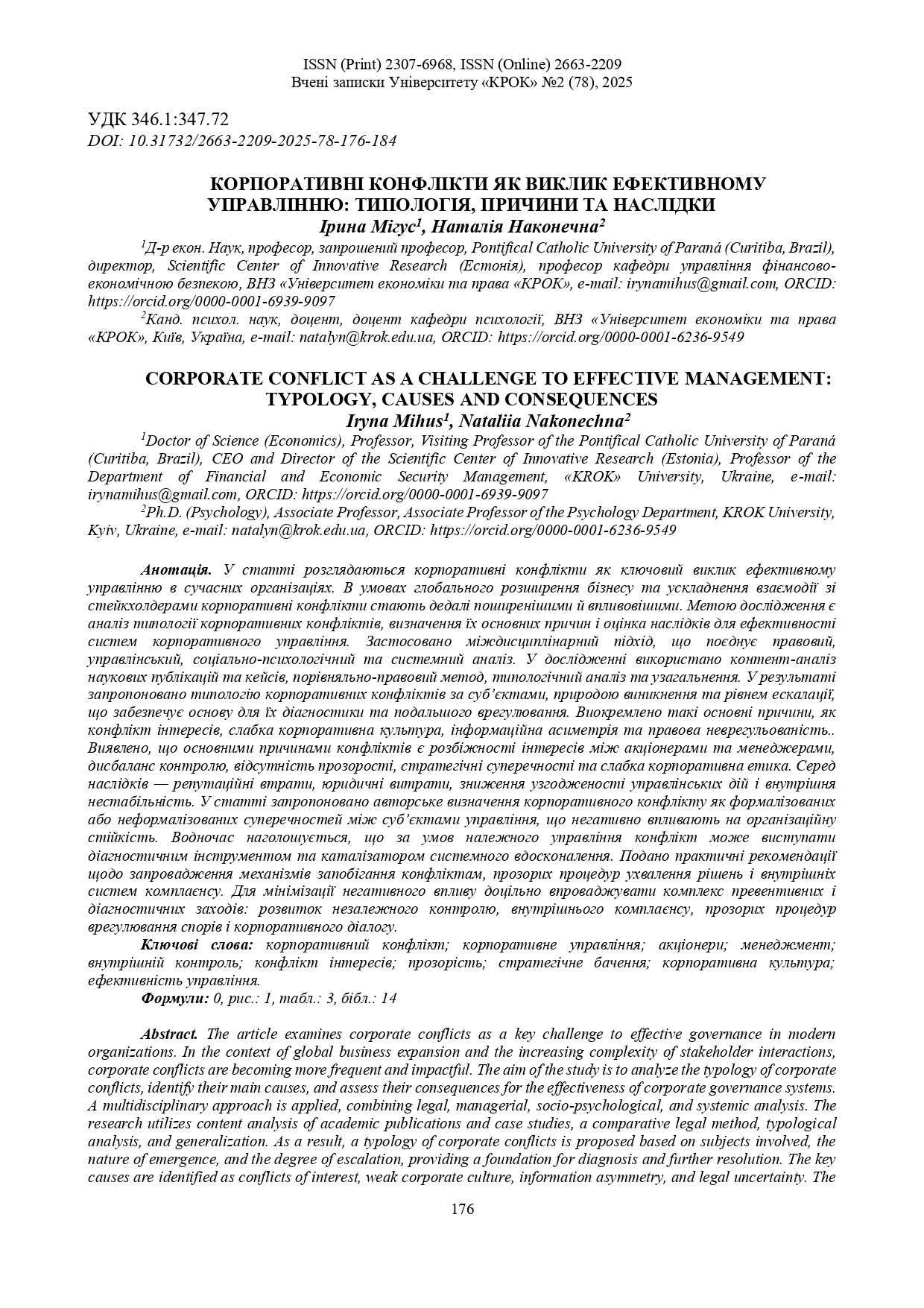CORPORATE CONFLICTS AS A CHALLENGE TO EFFECTIVE GOVERNANCE: TYPOLOGY, CAUSES, AND CONSEQUENCES
DOI:
https://doi.org/10.31732/2663-2209-2025-78-176-184Keywords:
corporate conflict, corporate governance, shareholders, management, internal control, conflict of interest, transparency, strategic vision, corporate culture, management efficiencyAbstract
The article examines corporate conflicts as a key challenge to effective governance in modern organizations. In the context of global business expansion and the increasing complexity of stakeholder interactions, corporate conflicts are becoming more frequent and impactful. The aim of the study is to analyze the typology of corporate conflicts, identify their main causes, and assess their consequences for the effectiveness of corporate governance systems. A multidisciplinary approach is applied, combining legal, managerial, socio-psychological, and systemic analysis. The research utilizes content analysis of academic publications and case studies, a comparative legal method, typological analysis, and generalization. As a result, a typology of corporate conflicts is proposed based on subjects involved, the nature of emergence, and the degree of escalation, providing a foundation for diagnosis and further resolution. The key causes are identified as conflicts of interest, weak corporate culture, information asymmetry, and legal uncertainty. The study reveals that the main drivers of conflict include interest divergence between shareholders and managers, imbalance of control, lack of transparency, strategic disagreements, and poor corporate ethics. The consequences include reputational damage, legal expenses, reduced coherence in management decisions, and internal instability. The article offers an original definition of corporate conflict as formal or informal contradictions between governance actors that negatively affect organizational resilience. At the same time, it is emphasized that, when properly managed, conflict can serve as a diagnostic tool and a catalyst for systemic improvement. Practical recommendations are provided for the implementation of conflict prevention mechanisms, transparent decision-making procedures, and internal compliance systems. To minimize negative impacts, it is advisable to introduce a set of preventive and diagnostic measures: the development of independent oversight, internal compliance, transparent dispute resolution procedures, and a corporate dialogue culture.
Downloads
References
Amason, A. C. (1996). Distinguishing the effects of functional and dysfunctional conflict on strategic decision making: Resolving a paradox for top management teams. Academy of Management Journal, 39(1), 123–148. https://doi.org/10.5465/256633
Bebchuk, L. A., & Weisbach, M. S. (2010). The state of corporate governance research. The Review of Financial Studies, 23(3), 939–961. https://doi.org/10.1093/rfs/hhp121
De Dreu, C. K. W., & Weingart, L. R. (2003). Task versus relationship conflict, team performance, and team member satisfaction: A meta-analysis. Journal of Applied Psychology, 88(4), 741–749. https://doi.org/10.1037/0021-9010.88.4.741
Eisenhardt, K. M. (1989). Agency theory: An assessment and review. Academy of Management Review, 14(1), 57–74. https://doi.org/10.5465/amr.1989.4279003
Eisenhardt, K. M., Kahwajy, J. L., & Bourgeois, L. J. (1997). How management teams can have a good fight. Harvard Business Review, 75(4), 77–85.
Gompers, P. A., Ishii, J. L., & Metrick, A. (2003). Corporate governance and equity prices. Quarterly Journal of Economics, 118(1), 107–156. https://doi.org/10.1162/00335530360535162
Jehn, K. A. (1995). A multimethod examination of the benefits and detriments of intragroup conflict. Administrative Science Quarterly, 40(2), 256–282. https://doi.org/10.2307/2393638
Jensen, M. C., & Meckling, W. H. (1976). Theory of the firm: Managerial behavior, agency costs and ownership structure. Journal of Financial Economics, 3(4), 305–360. https://doi.org/10.1016/0304-405X(76)90026-X
Kaptein, M. (2008). Developing and testing a measure for the ethical culture of organizations: The corporate ethical virtues model. Journal of Organizational Behavior, 29(7), 923–947. https://doi.org/10.1002/job.520
La Porta, R., Lopez‐de‐Silanes, F., Shleifer, A., & Vishny, R. W. (1999). Investor protection and corporate governance. Journal of Financial Economics, 58(1–2), 3–27. https://doi.org/10.1016/S0304-405X(00)00065-9
Mallin, C. A. (2019). Corporate governance (6th ed.). Oxford University Press.
OECD. (2015). G20/OECD Principles of Corporate Governance. OECD Publishing. https://doi.org/10.1787/9789264236882-en
Rahim, M. A. (2001). Managing conflict in organizations (3rd ed.). Greenwood Publishing Group.
Tjosvold, D. (2008). The conflict-positive organization: It depends upon us. Journal of Organizational Behavior, 29(1), 19–28. https://doi.org/10.1002/job.473

Downloads
Published
How to Cite
Issue
Section
License

This work is licensed under a Creative Commons Attribution-NonCommercial 4.0 International License.

